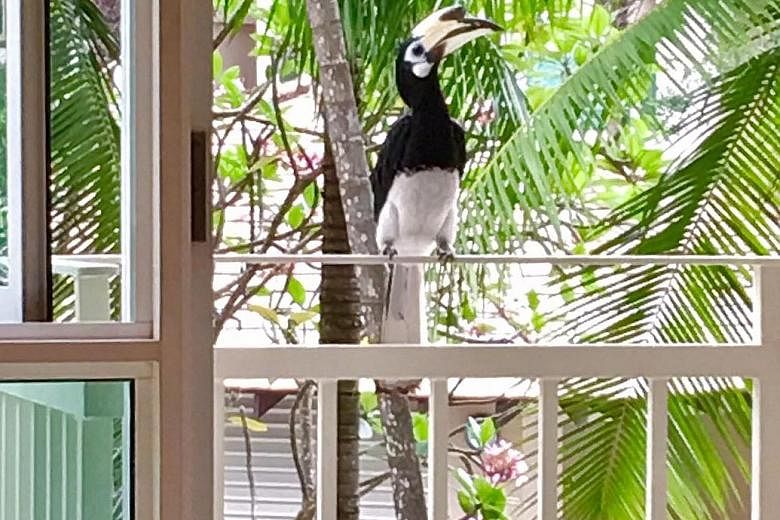A pair of oriental pied hornbills have been spotted at Country Park Condominium in Bedok, creating quite a stir among residents.
First seen there in January, the birds are now known to frequent the condo in the late afternoon when the weather is cooler, to forage for fruit from the estate's palm trees, say residents.
Oriental pied hornbills can be identified easily due to their size, distinctive yellow horn-topped beaks, and black and white plumage.
While the natural habitats of hornbills are moist lowland forests, "it is not unusual to see them in built-up areas", said Dr Lena Chan, group director of the National Biodiversity Centre of the National Parks Board (NParks).
"The hornbill has been able to adapt to a more urban environment," she added.
These native Singapore birds, once thought to be extinct here, can now be seen all over the island.
In fact, there are around 100 oriental pied hornbills in Singapore today, cementing the bird's position as a poster child for species rehabilitation here.
The birds were thought to have disappeared for good here for over 100 years, until a pair reappeared in Pulau Ubin in 1994.
Since then, there has been an ongoing effort to ensure the continued survival and proliferation of this striking bird species.
In 2004, NParks worked with partners, including the National University of Singapore, Nanyang Technological University and Jurong Bird Park, on the Singapore Hornbill Project. This project studied the breeding and nesting patterns of the birds to find out how this species could be repopulated. Part of the effort included designing nest boxes for breeding pairs.
Following the success of the project, a hornbill breeding programme was conducted in the Istana in 2008 by NParks, Jurong Bird Park, researcher Marc Cremades and Professor Ng Soon Chye.
While their numbers may be relatively small, the hornbill population in a place the size of Singapore is "not insignificant", said NParks, and it demonstrates what can be done to encourage the fairly rapid population increase of a large bird species in an urban setting.
But if you do see the hornbills, do not get too close and definitely do not feed them, say the experts. Dr Chan stressed that people should observe them from a distance and not feed them as there are sufficient food sources in the wild.
Keeping a natural diet is important for the hornbills as they help disperse seeds from the wild fruit they consume. "By not feeding them, we can ensure they continue to disperse seeds and help with forest regeneration," she said.
As the birds continue to thrive and explore new territory here, more people are experiencing the thrill of spotting them.
Said Country Park Condominium resident Priscilla Ti, 40, who is self-employed: "While we were surprised to see the hornbills in the beginning, we are now excited whenever they are around."

